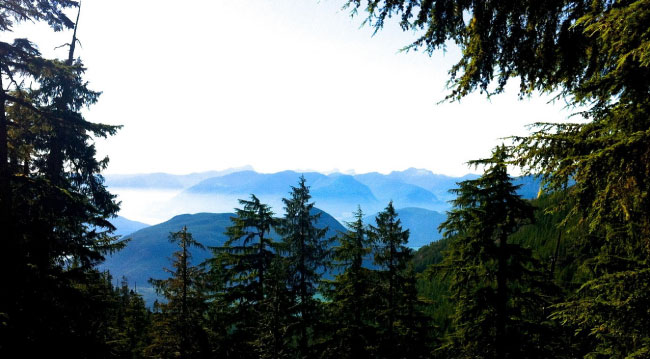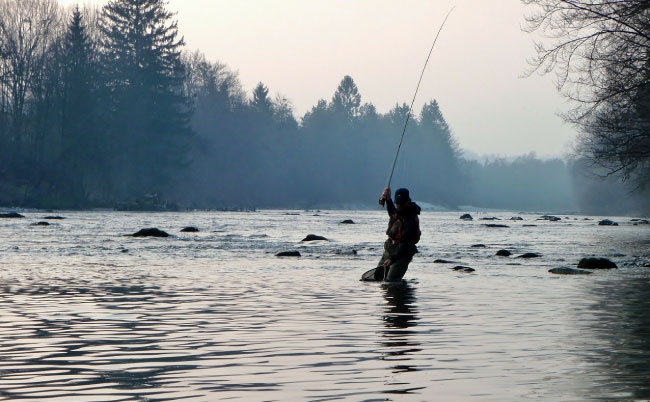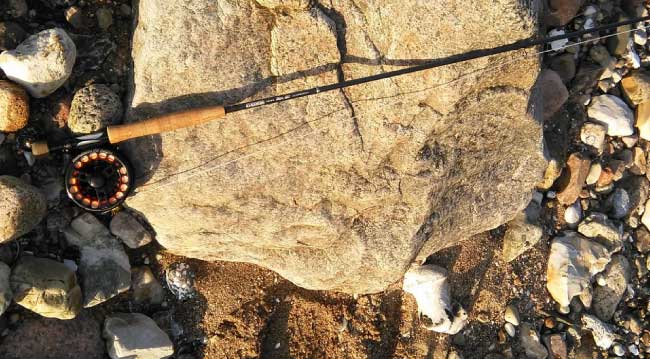Fly Fishing Squamish River. Outdoors and travel writer Norman Dacanay describes his journey as a novice fly-fisherman. Will it end in success or will he forever be rueing the ‘one that got away’?
[mc4wp_form]
Hooked – Wading Into The Waters As A Novice Fly-Fisherman
Nestled on the Sea-to-Sky Highway, in between the pricey homes of West Vancouver and the world renowned winter destination of Whistler, lies the town of Squamish. Once a hub of British Columbia’s booming logging industry, it now bills itself as the ‘Outdoor Recreation Capital of Canada’. Following the departure of most of its industry, which included chemical facilities, pulp mills and mining, the town now relies on tourism and recreation for revenue. Squamish now offers world-class mountain biking with hundreds of trails and single tracks. Some of the best rock climbing in the country can be found on the rock faces of the Smoke Bluffs and the iconic granite monolith, the Stawamus Chief. But, the waters that surround and run through the town are the liquid gems in its crown.
Fishing Squamish River
The Squamish River dominates the western border of the town. Fed by melting glaciers hundreds of kilometers away and strengthened by several tributaries which include the Elaho, Ashlu, Cheakamus, Cheekye and Mamquam rivers. On a map, the Squamish River looks like a sapphire snake winding its way through the Coastal Mountain Range and eventually finding its way to the river delta, and spilling out into Howe Sound. The town itself sits at the tip of the Sound, a tidal fjord that eventually makes its way to the Pacific Ocean. And it is this relationship between the open Pacific and the inland streams that allows Squamish to play host in-part to one of natures largest migrations: the Pacific Salmon Run.
Squamish’s waters mainly attract three species of Pacific Salmon; Chum, Coho and Pink. Sea-Run Rainbow trouts called Steelhead can also be found migrating into Squamish’s Rivers and is as highly prized as any salmon. It is these four fish that I set my sights on and after consulting with locals and anglers it looked like the best and “funnest” way to catch them was on a fly rod. This sounded like a great idea, but I ran into a couple of issues. I did not have a fly rod. I did not know how to use a fly rod. I did not know how to fly-fish. And, I’ve never caught a fish…ever. Needless to say I had my work cut out for me. What I needed was some expert help to get the right gear and (being cut from the do-it-yourself cloth) some sort of manual or guide to learn how to fly fish.

On Vancouver’s busy street of West Broadway sits the fly fishing institution of Michael & Young. Providing fly-fishing gear, courses, advice and trips since 1985, it was my first and only stop to get my gear. I must admit that I felt a bit intimidated when I walked into that store, not because of the guys behind the counter (they were extremely easy to talk to) but because I knew absolutely nothing about what I was getting into, except for the fact that I needed something to catch fish with. After discussing details like fishing location (From a boat? From the shore? Is it an open area or will there be obstacles like trees?), current types (Will I be fishing in still water or in current?) and budget.
I was handed my first fly fishing rod. It was an 11-foot, 2-piece and came packaged with a matching fly reel with backing, a yellow-green fluorocarbon fly line and fast sinking leader. They even threw in a couple of flies for good measure. I was now armed to the teeth with the tools needed to land a hefty salmon. Now I just needed to find out how. Orvis…the name kept popping up everywhere I looked for flyfishing information. I decided to dig deeper into this company and found that they are an industry leader with a pedigree to match. I devoured their instructional videos on YouTube and purchased ‘The Orvis Guide to Fly Fishing: More Than 300 Tips for Angles of All Levels‘, what the bookstore clerk reverently called “The Bible”. Using these I armed myself with enough knowledge to get myself out on the water and casting my line. All I needed was the fish, and they were coming. By this point it was early October and after a particularly dry summer the first showers of fall have finally come and the Run was starting in earnest.
Fisherman’s Park is a mecca for fly-anglers in the Sea-to-Sky corridor. Tucked away in the neighborhood of Brackendale, lies the long gravelly shore that is particularly conducive to fly fishing. The shore gently slopes down into the river where fishermen can comfortably wade into the current and get a line out. The tree line sits a fair distance away from the fishing area and this means that a fisherman can really swing a fly rod without fear of snagging a shrub or some other obstruction. As I wriggled into my hip waders I thought about the various flies and streamers that I had at my disposal. Which would I use? After recalling my conversations and my readings I settled on using streamers, in particular green wooly buggers, purple marabous and shiny streamers. As I walked the small trail connecting the parking lot to the fishing grounds I played over and over in my head the sequence of casting, as much as I want to say that I did this to hone my technique, I equally did it to ease my anxiety and apprehension.
I decided to go with the purple marabou and, with it tied to my line, waded into the cold Squamish River. As I stripped some line out from my reel I surveyed the water for any sign that might betray the locations of the fish that swam below its surface. I begin to whip the rod back and forth causing the heavy fly line to shoot through the guides of the rod and increasing the distance it covered in the water. The line landed in the water and I began to strip the streamer back to me, with each tug the purple marabou streamer mimics a small fish or creature moving through the water. Ten minutes pass and not a nibble. From the corner of my eye I see another fisherman leaning back, his rod bent, line taut and fighting what looked like a rather big fish. When will I get my turn? It is at this point that I had to exercise the one thing that I had so very little of: Patience. Three casts later I got my first nibble. So excited was I, so overcome with some primal joy that I forgot to set the hook and when I started to crank the reel the fish spat it out. I was heartbroken in an instant, but it passed quickly, because I knew there was hope and that it was possible for me to hook and land a fish.

I shot my line back out on the river and for the next hour I was able to hook and tussle with salmon on several occasions. On one particular engagement the salmon bit down on my lure a mere five feet from where I was standing. It then swam away with the force and speed of a torpedo. The salmon smoked my line out all the way to the backing and then as quickly as it came; it was gone as it broke off my hook. On another cast I hooked a rather strong individual full of stamina. After a successful cast and hook set the fish started to swim back and forth, going this way and that in an attempt to stay away from the shore and being landed. I wrestled with my rod for what seemed like hours but in reality was more like ten minutes. My quarry kept zigging and zagging and I had to move down the shoreline several times, apologizing to other fishermen as I wove myself through their lines. My right forearm was burning at this point. I actually had to switch hands for a minute just to gain a bit of reprieve from the lactic acid buildup. Unfortunately, this fish ended up breaking free as well. I felt happy, yet a little defeated. I really wanted to land a fish, even if it was just once that day.
Two casts later I got my chance. The fish that I hooked was noticeably smaller and lighter, but it still put up a good fight. The weight of the fish made me think for a moment that I may have hooked a medium-sized brown trout, but as it broke the surface I could see its silver side and knew that it was some sort of salmon. Using the power in my muscles and my 7/8 weight rod, I landed the fish. What I saw was definitely a salmon, definitely a juvenile, but it was missing the adipose fin which indicates that this is a Coho that was spawned from a hatchery found a couple of kilometers upriver. But nonetheless, this was my first landed fish, my first catch. Nothing was going to take this away from me and I can finally, officially, call myself a fisherman. All those hours of reading, watching videos, practicing casts and knots have finally paid off. But as I removed my hook and released the young Coho back into the river, I thought to myself, This is the first…of many. And with that I stood back up, got my line ready and waded back into the water to cast my line out into the water once more.
By Norman Dacanay

